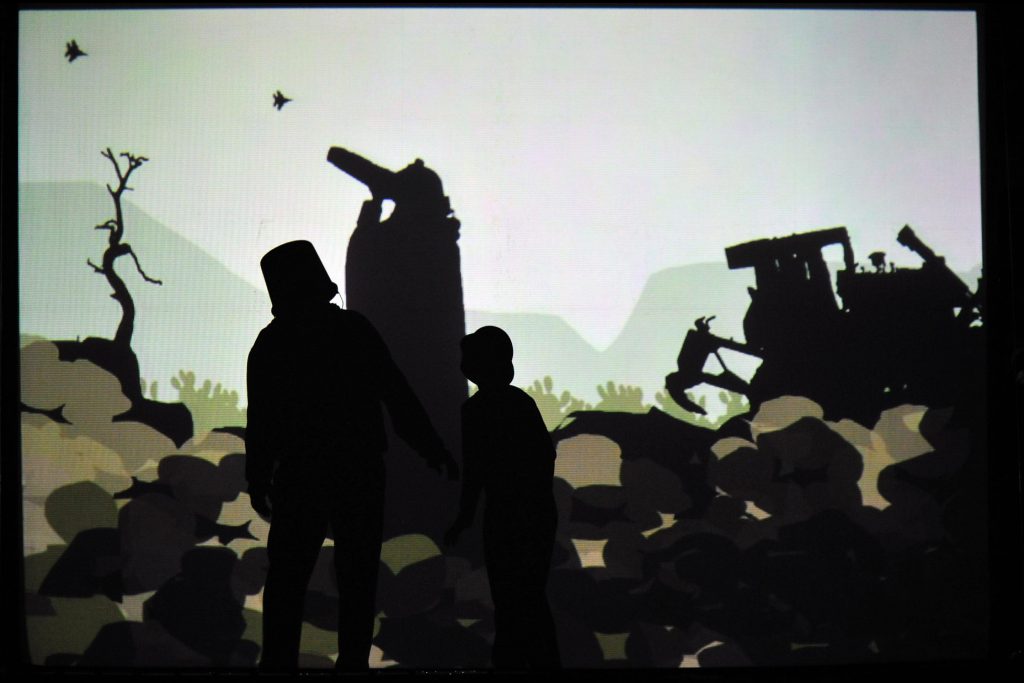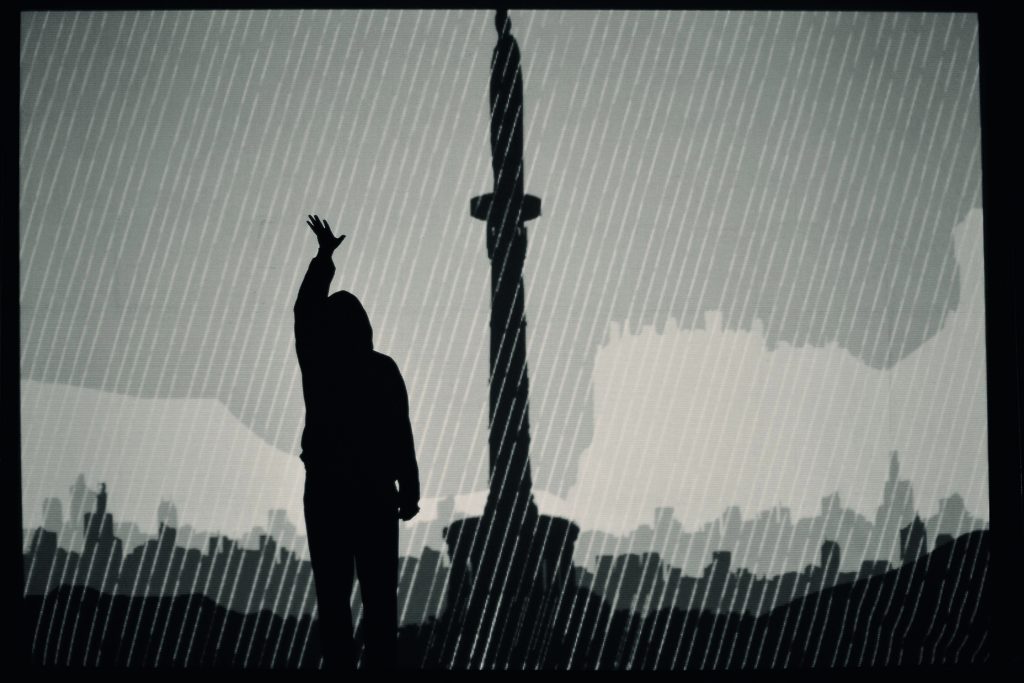Matthias Reichelt
To depict rebellion, violence, and war, artists can choose from a wide variety of strategies. In her latest video piece The King Is Blind (2011) Sharon Paz manages to tell a story of oppression and rebellion without giving any clear hints about the setting.
Painting in black and white is a metaphor that in a single phrase outlines the greatest polarity of perspective and position possible. Principles and tendencies become much more explicitly presentable through this exact differentiation and by refraining from using a big palette of shades of gray. Sharon Paz’s films, which in their aesthetics are reminiscent of woodcuts, capture a clearly defined and sharp view of reality. Her video piece The King Is Blind includes a series of different scenes that fade to black. They show fantastic images that are sharp and rich in contrast, clear in content, but nevertheless also possess a high level of abstraction.
Paz concentrates all revolts and reigns of terror into one pars pro toto. She presents images of strong suggestive power which, due to their combination of fantastic landscapes, mythological motives, and modern-day objects, remain completely ambivalent with regard to the history of mankind. The aesthetic appeal of this artistic “narrative” lies in the discrepancy between the seemingly romantic scenery, the surreal, composed landscapes, and the individual hyper-realistic elements that immediately activate the observer’s topical visual memory. Warships, protesters with raised fists, demonstrators with banners and flags, as well as people who practice their faith by kneeling down to pray, all quote the visual canon of modern day theaters of war. Images showing a withered, burned tree, a figure with a telescope or possibly an anti-aircraft missile, a bulldozer, and planes shooting past in the sky immediately call Afghanistan to mind.

In Sharon Paz’s work this narrative willfully remains vague because her work is about the conditio humana in times of oppression, revolt, and war. The artist resists all temptations to deliver a complete and flowing narrative. She rather reduces a possible plot to metaphoric images that the observer then has to compose into a narrative inside their head. Her works are animated films that in their aesthetic appearance recall cartoons, yet are manufactured differently. The landscapes are based on elements copied from the internet as well as the artist’s computer-generated drawings. The figures are silhouettes of actors she films through a screen and then fits into the landscapes on the computer thus creating a change in scenery, cultural contexts, and individual components, as well as in the genres from which they have been taken.
During her performative screenings Paz integrates the shadows of the live actors and thereby manages to create up to three narrative levels, differing from scene to scene. The transitions to black between scenes are analogous to the fall of the curtain in the theater, allowing the artist to introduce a new setting which refers to a new scene and a new cultural and geographical context.
In this way the images show different states of a possible story. The first scene is accompanied by a thunderstorm that emphasizes the criminal act of oppression and torture, just as darkness emphasizes the crime in the film noir. A lighthouse illuminates the craft of the torturers with its beam. The island in this scene is the silhouette of Alcatraz, the notorious defunct prison island set in the bay of San Francisco. In Sharon Paz’s work it represents all possible penitentiaries worldwide. First a rowboat in front of the island and later the whole island itself begins to sink, while on the water’s edge a person stooped with a heavy burden moves out of the scene twice. The king with his white cane, unimpressed by the events, passes through the scene in the background. Two mythological motifs, Sisyphus and Atlantis, are being cited in this dense scene.
In another act people pray in Muslim, Christian, and Jewish fashion, in and around a cave. In the very foreground a deer decoy with a target attached moves across the scene from left to right. If the shooters miss their target, they shoot the people behind it.¹ A watchtower, a very distinct piece of architecture known from forts, kibbutzim, and prisoner camps, can be seen on the right side of the horizon. In Europe its metaphorical connection is mainly to the Nazi concentration and death camps. Entering from the right, the blind king — discernible from his crown, cape, and white cane — is groping his way along a bridge without noticing the events while striding towards a rhinoceros that is blocking the far end of the footbridge. In front of the bridge another person, to whom the crossing has been denied, is making their way across the abyss, hand over hand, along a rope.
A ruler that cannot see is incapable of understanding problems, of reading the writing on the wall: he is a symbol for the ignorance of power; that which does not have an eye for seeing the sorrows of the people, but simultaneously misjudges the growing displeasure that is about to degenerate into violence.
The next scene is split horizontally, the sky and the landscape dipped in different colors. In the upper half we can see a warship stranded on top of a mountain, above which a half-moon is hanging. Burning industrial plants function as a clear sign of war. In contrast, the scene below shows a peaceful world of hedonism, including a person skipping stones across the water and a piper with his dog. Peaceful situations, wars and asymmetrical wars, armistices, and skirmishes as simultaneous events have become the everyday life in a world globalized by the media.
Paz’s video piece ends with the king on top of a pillar (the silhouette of the Siegesäule, the Victory Column), surrounded by cheering followers. Another thunderstorm follows, the king remains left behind, alone and abandoned. In the end all that is left is the pillar; the king has disappeared and the story could just as well start all over again.
Notes: A documentary reminder of the video filmed on July 12 2007 and made public by WikiLeaks on April 5 2010 showing civilians being shot from the perspective of a shooter seated in an US Army helicopter.

MATTHIAS REICHELT, Born 1955 in Leipzig, GDR, raised in Federal Republic of Germany. Studied American Studies and German Literature at the FU Berlin. Freelance Curator, Author, and Editor, currently living in Berlin. Has written several reviews of art and literature, and articles on political subjects in “Kunstforum International,” “Tagesspiegel,” “zitty,” as well as essays for books.